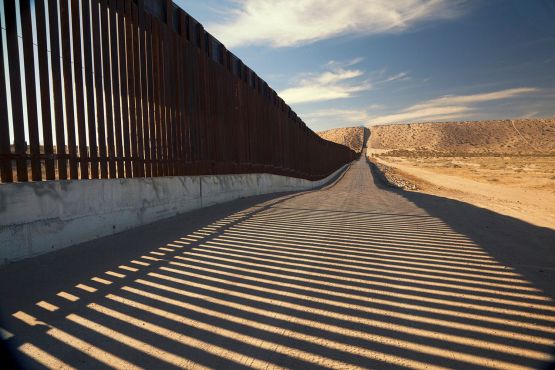
Toggle Search Search Close
Preferences Show me.
We want to provide announcements, events, leadership messages and resources that are relevant to you. Your selection is stored in a browser cookie which you can remove at any time using “Clear all personalization” below.
Clear all personalization
Close preferences Close
From 2007 to 2010, the United States built an additional 548 miles of fencing across the U.S.-Mexico border. The fence came at a high cost to American taxpayers and only minimally reduced unauthorized Mexican migration, according to new research by economists at Stanford and Dartmouth.

Additional fencing between the United States and Mexico had only a tiny effect on migration while burdening American taxpayers with significant costs, according to a new study by Stanford and Dartmouth researchers. (Image credit: Getty Images)
The new working paper – co-authored by Stanford economist Melanie Morten, Stanford doctoral candidate Cauê Dobbin and Dartmouth economist Treb Allen – examines the effects of the Secure Fence Act of 2006, which added 548 miles of border fence between the two countries. At a cost of $2.3 billion, the expansion raised total fencing to 658 miles, one-third of the entire U.S.-Mexico border.
Morten and her collaborators embarked on the study in the summer of 2016 after seeing a need for more empirical evidence on the effects of the border wall amid ongoing debates over immigration. Their 101-page study is abridged in an executive summary. The working paper is slated to be posted online by the National Bureau of Economic Research on Nov. 19.
“Overall, we find that the additional fencing had a very small effect on migration and an overall negative effect on the economy,” said Morten, an assistant professor of economics and faculty fellow at the Stanford Institute for Economic Policy Research (SIEPR). “The wall was expensive to U.S. taxpayers – they paid roughly $7 per person – but saw little to no economic benefits as a result. Some even saw their welfare fall.”
The wall did not significantly curtail migration, according to the research. Using data from Mexican consulates on the flow of adult Mexican citizens who migrated between 2006 and 2010, the researchers estimated that the wall expansion reduced the total number of Mexican-born workers coming into the United States by only 0.6 percent, roughly 83,000 people.
Further analysis showed that the expansion of the wall largely harmed American workers. College-educated U.S. workers lost an equivalent of $4.35 in annual income, while less-educated U.S. workers benefited on average by only 36 cents. Taken together, “the costs far outweigh the benefits, even for low-skilled workers in the U.S.,” Morten said.
Mexican citizens tended to migrate to attain higher wages. The wall did not change that.
Melanie Morten
Assistant professor of economics
Allen, who was a visiting fellow at SIEPR during the 2015-16 academic year and is the Distinguished Associate Professor of Economics and Globalization at Dartmouth, said, “Our analysis incorporated both the direct impact of the border wall expansion on the cost of migrating as well as the complex ways in which the expansion indirectly impacted workers throughout the economy. Given the costs of constructing the wall were so large, it is striking that the benefit was so small.”
Most Mexican-born migrants, the study found, still opted to come to the U.S. even though the additional border barriers altered their migration paths and made the journey more difficult.
“If the goal of policy is to reduce migration, it’s important to examine what leads people to migrate in the first place,” Morten said. “Mexican citizens tended to migrate to attain higher wages. The wall did not change that.”
Lowering the costs of trade between the U.S. and Mexico, which should, in turn, increase wages in Mexico, would be a potential example of an alternative policy to reduce migration, she said.
In their study, the researchers tested this concept by simulating a 25 percent reduction in trade costs between Mexico and the United States. Their analysis suggests that trade policy would be more effective in reducing migration than the border wall and that it would benefit workers in both countries.
According to the researchers, instead of facing an economic loss as they did with the wall, college-educated U.S. workers would see an equivalent economic boost of $80.59 in annual income, while less-educated U.S. workers would see their economic gain rise, on average, by $58.67 in annual income.
Economic theory suggests that migration depends on both the costs of migrating and returns from doing so, the researchers wrote in their executive summary. Policies that improve economic outcomes in Mexico, such as reducing trade costs, “may be more effective in reducing migration while also benefiting U.S. workers,” the researchers concluded.
Adam Gorlick, Stanford Institute for Economic Policy Research: (650) 724-0614, agorlick@stanford.edu
Melanie Morten, Assistant Professor of Economics Stanford: memorten@stanford.edu
Treb Allen, Associate Professor of Economics and Globalization, Dartmouth: treb.allen@dartmouth.edu